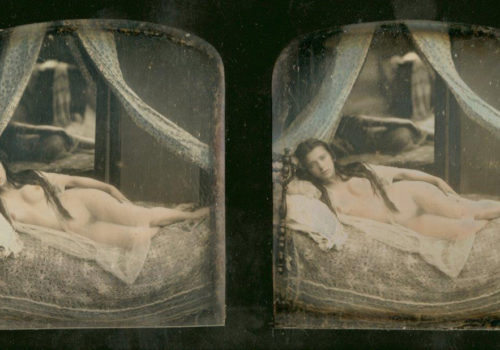Over three decades, British born, New York-based photographer Adam Fuss has created a body of work that combines photographic techniques of the past with contemporary materials. His pinhole photographs and cameraless photograms, executed with technical rigor in a variety of media, have dealt with temporality, memory, regeneration, and death. The exhibition at Hans P. Kraus Photographs, in New York, presents a remarkable suite of Fuss’s large-scale daguerreotypes that deepens his exploration into these themes. These are the largest daguerreotypes ever made. Prefacing the exhibition is Fuss’s selection of 19th century daguerreotypes of nudes and post-mortem studies.
Fuss’s fascination with early processes and 19th-century photographic themes made him a frequent visitor to Hans P. Kraus Jr. Fine Photographs. “Adam was often the first through the door when the gallery had a new group of 19th-century photographs to show,” says Kraus. “Given his enthusiasm for our stock-in-trade, it seemed only natural for us to collaborate with Adam on this exhibition.”
Adam Fuss’s work with the daguerreotype has brought this seminal photographic technique into the 21st century. He has exploited the daguerreotype’s remarkably sharp resolution to create images with a nearly three-dimensional quality and remarkable physical presence. The central motif in each image is the bed, and Fuss’s daguerreotypes encompass its association with sleep, dreaming, sex, childbirth, and death.
Fuss says: “The daguerreotypes on exhibit at Hans Kraus’s gallery are the result of my continued investigation into the dualistic aspects of the ancient symbol of the snake. I was trying to reconcile its negative incarnation in the Snakes and Ladders game of my childhood with its positive incarnation in the photograms I made in the 1980s. The snake is symbolic of healing and is represented, even today, on every ambulance. Yet, the snake is entwined in the biblical story of Eve and the expulsion from Eden. The daguerreotype, with its shifting positive and negative values, seemed the ideal medium with which to pursue this investigation.”
Adam Fuss compliments these new daguerreotypes with nude studies and images of the dead from the 19th century. “My selection of 19th-century images builds upon the idea that the arrival of the daguerreotype initiated a fundamental shift in the brain’s response to visual information, changing art forever. The paintings of the Pre-Raphaelites, in particular, can be seen as response to the arrival of the daguerreotype. The Pre-Raphaelite obsessions with light, accurate depiction of detail, and the themes of love and death are all present within the within these early photographic images.”
Adam Fuss Daguerrotypes
Through December 2, 2016
Hans P. Kraus Photographs
962 Park Ave
New York, NY 10028
USA
















